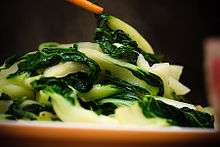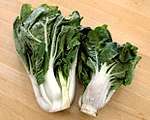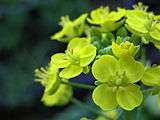Bok choy
Bok choy (American English), pak choi (British English), or pok choi (Brassica rapa subsp. chinensis) is a type of Chinese cabbage. Chinensis varieties do not form heads and have green leaf blades with lighter bulbous bottoms instead, forming a cluster reminiscent of mustard greens. Chinensis varieties are popular in southern China and Southeast Asia. Being winter-hardy, they are increasingly grown in Northern Europe. Now considered a subspecies of Brassica rapa, this group was originally classified as its own species under the name Brassica chinensis by Carl Linnaeus. They are a member of the family of Brassicaceae or Cruciferae, also commonly known as the mustards, the crucifers, or the cabbage family.
| Bok choy | |
|---|---|
Brassica rapa chinensis, called "bok choy" in the United States | |
| Species | Brassica rapa |
| Cultivar group | Chinensis |
| Origin | China, 5th century AD[1] |
Spelling and naming variations
| Cooked bok choy | |
|---|---|
 | |
| Chinese name | |
| Chinese | 青江菜 |
| Hanyu Pinyin | qīngjiāngcài |
| IPA | [tɕʰíŋ.tɕjáŋ.tsʰâi] |
| Romanization | tsching tsae |
| Cantonese and Southern Min name | |
| Chinese | 白菜 |
| Yale Romanization | baahk choi |
| Jyutping | baak6 coi3 |
| IPA | [pàːk tsʰɔ̄ːy] |
| Hokkien POJ | pe̍h-chhài or pe̍eh-chhài |
| Korean name | |
| Hangul | 청경채 |
| Hanja | 靑莖菜 |
| Revised Romanization | cheonggyeongchae |
| Japanese name | |
| Kanji | 青梗菜 |
| Katakana | チンゲンサイ |
| Romanization | chingensai |
Other than the ambiguous term "Chinese cabbage", the most widely used name in North America for the chinensis variety is simply bok choy (Cantonese for "white vegetable") or siu bok choy (Cantonese, for "small white vegetable"; as opposed to dai bok choy meaning "big white vegetable" which refers to the larger Napa cabbage). It can also be spelled pak choi, bok choi, and pak choy. In the UK and South Africa, the term pak choi is used. Less commonly, the descriptive English names Chinese chard, Chinese mustard, celery mustard, and spoon cabbage are also employed.
In Australia, the New South Wales Department of Primary Industries has redefined many transcribed names to refer to specific cultivars. In addition, they have introduced the word buk choy to refer to a specific kind of cabbage distinct from pak choy.[2][3]
In China, the majority of Chinese speak Mandarin (about 955 million people); for them, the term used most commonly is 青菜 qīng cài (literally "green vegetable"). Although the term 白菜 is pronounced "baak choi" in Cantonese, the same characters are pronounced "bái cài" by Mandarin speakers and used as the name for Napa cabbage which they call "Chinese cabbage" when speaking English.
In the Philippines, it is called péchay in Spanish and pichay or petsay in Tagalog.[4][5]
What is labelled Bok Choy may come in 2 forms: traditional true bok choy (Chinese: 小白菜; lit.: 'small white vegetable') or Shanghai bok choy (Chinese: 上海青; lit.: 'Shanghai green'). Regular bok choy is usually more expensive and has a dark crinkly colored leaves and stem portions that are white and crisp texture that is more suitable to Cantonese style cooking, stir fries, and simple or raw preparations.[6] Shanghai bok choy has greater availability in most American Markets and has mild tasting spoon shaped leaves that are lighter green with stems that are jade green instead of white. The texture of Shanghai bok choy is less crisp and gets slimy if overcooked for too long but can otherwise be substituted in many cooking applications when true bok choy is unavailable.[7]
Nutritional value
| Nutritional value per 100 g (3.5 oz) | |
|---|---|
| Energy | 54 kJ (13 kcal) |
2.2 g | |
| Dietary fiber | 1.0 g |
0.2 g | |
1.5 g | |
| Vitamins | Quantity %DV† |
| Vitamin A equiv. | 30% 243 μg25% 2681 μg |
| Thiamine (B1) | 3% 0.04 mg |
| Riboflavin (B2) | 6% 0.07 mg |
| Niacin (B3) | 3% 0.5 mg |
| Pantothenic acid (B5) | 2% 0.09 mg |
| Vitamin B6 | 15% 0.19 mg |
| Folate (B9) | 17% 66 μg |
| Vitamin C | 54% 45 mg |
| Vitamin K | 44% 46 μg |
| Minerals | Quantity %DV† |
| Calcium | 11% 105 mg |
| Iron | 6% 0.80 mg |
| Magnesium | 5% 19 mg |
| Manganese | 8% 0.16 mg |
| Potassium | 5% 252 mg |
| Sodium | 4% 65 mg |
| Other constituents | Quantity |
| Water | 95.3 g |
| |
| †Percentages are roughly approximated using US recommendations for adults. | |
Raw bok choy is 95% water, 2% carbohydrates, 1% protein and less than 1% fat (table). In a 100 gram amount, raw bok choy supplies 13 calories and is a rich source (20% or more of the Daily Value, DV) of vitamin A (30% DV), vitamin C (54% DV) and vitamin K (44% DV), while providing folate, vitamin B6 and calcium in moderate amounts (10–17% DV) (see table).
Bok choy was ranked #2 for nutrient density out of 41 nutrient-rich plant foods.[8]
Toxic effects
Bok choy contains glucosinolates. These compounds have been reported to prevent cancer in small doses, but, like many substances, can be toxic to humans in large doses, particularly to people who are already seriously ill. In 2009, an elderly diabetic woman who had been consuming 1 to 1.5 kg of raw bok choy per day in an attempt to treat her diabetes developed hypothyroidism for reasons relating to her diabetes, resulting in myxedema coma.[9] According to the case study published by her treating physicians, raw bok choy releases an enzyme which can inhibit the uptake of iodine, when eaten in large amounts over extended periods.[10]
History
Bok choy evolved in China, where it has been cultivated since the 5th century AD.[1]
Gallery
 True bok choy
True bok choy- Shanghai bok choy
 B. rapa chinensis
B. rapa chinensis B. rapa chinensis has yellow flowers
B. rapa chinensis has yellow flowers
See also
References
- Sanderson, Helen; Renfrew, Jane M. (2005). Prance, Ghillean; Nesbitt, Mark (eds.). The Cultural History of Plants. Routledge. p. 115. ISBN 0415927463.
- "Help is on the way for consumers confused by the wide array of Asian vegetables on sale". 2009-10-22. Archived from the original on 2007-08-20. Retrieved 2011-09-08.
- "Asian vegetable names" (PDF). Archived from the original (PDF) on 2006-10-30. Retrieved 2011-09-08.
- Vanjo Merano (28 June 2009). "Ginisang Pechay (Sautéed Bok Choy)". Panlasang Pinoy. Retrieved 20 August 2018.
- Edgie Polistico (2017). Philippine Food, Cooking, & Dining Dictionary. Anvil Publishing. ISBN 9786214200870. Retrieved 20 August 2018.
- https://farmtotableasiansecrets.wordpress.com/2011/10/05/shanghai-bok-choy/
- https://www.cooksillustrated.com/how_tos/10526-regular-vs-shanghai-baby-bok-choy
- di Noia, Jennifer (2014-06-05). "Defining Powerhouse Fruits and Vegetables: A Nutrient Density Approach". Preventing Chronic Disease. 11: E95. doi:10.5888/pcd11.130390. ISSN 1545-1151. PMC 4049200. PMID 24901795. Retrieved 2014-06-11.
- Rabin, Roni Caryn (2010-05-24). "Regimens: Eat Your Vegetables, but Not Too Many". The New York Times. Retrieved 2010-06-03.
- Chu, Michael; Seltzer, Terry F. (May 20, 2010). "Myxedema Coma Induced by Ingestion of Raw Bok Choy". New England Journal of Medicine. 362 (20): 1945–1946. doi:10.1056/NEJMc0911005. PMID 20484407.
External links

